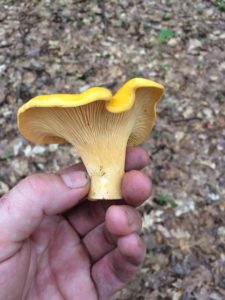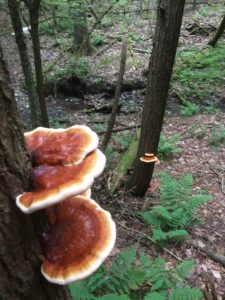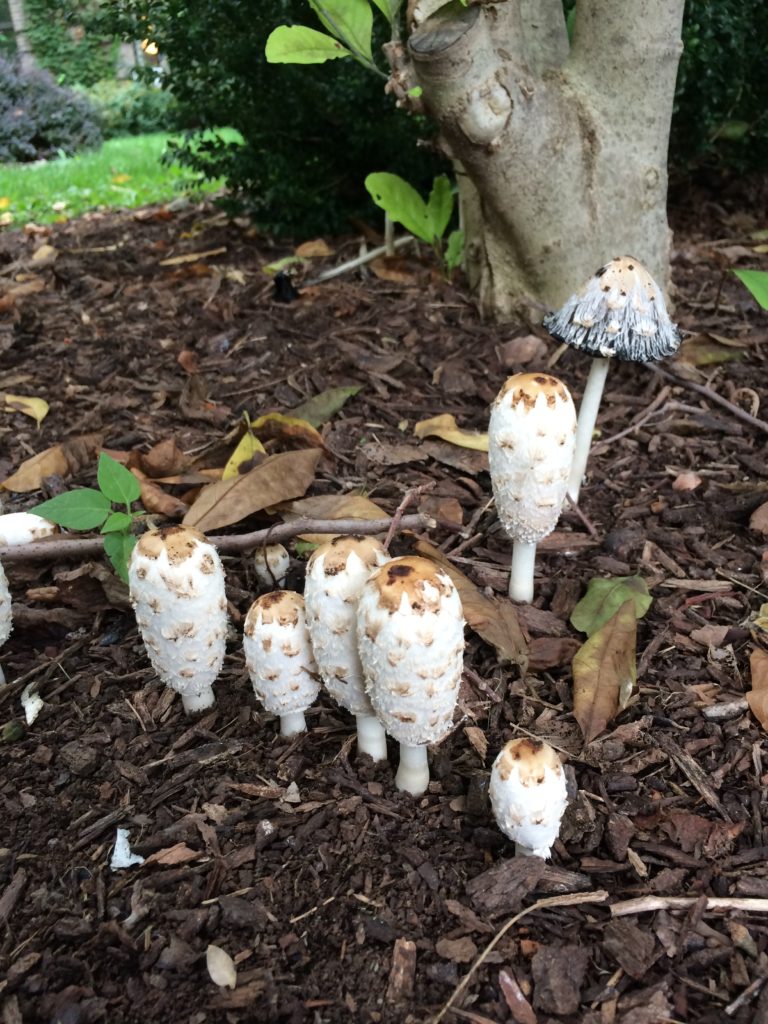DISCLAIMER:
Our online, print, and video resources are for public information purposes only. Any person who is intentionally cultivating or wild harvesting mushrooms is solely responsible and liable for the safety and accuracy of all products sold and consumed. The Cornell Small Farms Program, Cornell University, and any affiliated organizations, employees, officers and representatives mentioned in our resources are not liable for any injury or damages resulting from any mis-identification of potentially toxic species or allergic reactions that may occur.
This recording is from February 2021 and outlines the current regulations and certification offering through Mushroom Mountain.
Guidance Document for Sale of Wild Harvested Mushrooms in NY
Updated 1/19/21
For residents of other states, we recommend checking with your local and state health department and/or agriculture department about regulations before selling wild harvested mushrooms.

Chanterelle mushroom
Summary
This document provides guidance on the latest perspective of New York State regulatory authorities with regard to the sale of Wild Harvested Mushrooms. This is for public information and education purposes only - our program has no say over any individuals or entities ability to wild harvest mushrooms.
Any “approved expert” is solely responsible and liable for the safety and accuracy of all mushrooms sold and consumed. The Cornell Small Farms Program, NYSDAM, NYSHD, and any affiliated organizations, employees, officers and representatives mentioned in this document are not liable for any injury or damages resulting from any misidentification of potentially toxic species or allergic reactions that may occur.
Definitions
Intentionally Cultivated: mushrooms grown where the grower inoculates a substrate (logs, beds, straw, etc) with a known strain or species of mushroom spawn. A dedicated space is created, whether outdoors and/or indoors, for the purpose of fruiting mushrooms.
Wild Harvested: mushrooms where no inoculation has occurred, and are instead “found” or “foraged” in the natural environment. If for sale these must be picked by an approved expert.
There is a significant difference with regard to safety of intentionally cultivated and wild harvested mushrooms. When intentionally grown, a substrate must be clean and free of contaminants (i.e. other molds or fungi) and is then inoculated with a known species that has been propagated in a sterile lab. It is almost certain that the intended species of mushroom will emerge from this process. Wild harvested mushrooms, on the other hand, come from the natural environment and of course there are many opportunities to mis-identify species.
Whether you are growing or foraging mushrooms, it is critical to develop proper identification skills and be able to confidently name 3 – 5 characteristics and how to take a spore print to confirm the identity of a mushroom you intend to sell. Consult our resource on identification for more info: LINK HERE
| INTENTIONALLY CULTIVATED ONLY | WILD HARVESTED ONLY | BOTH CULTIVATED AND WILD HARVESTED |
| Shiitake (Lentinula edodes)
Chestnut (Pholiota adiposa) King Trumpet (Pleurotus eryngii) |
Chanterelles (Cantharellus spp.)
Morels (Morchella spp.) Chicken of the Woods (Laetiporus spp.) |
Oyster Mushroom (Pleurotus spp.)
Lions Mane or Pom Pom (Hericium spp.) Maitake (Grifola frondosa) |
Examples of species in different categories. Note that is list is not complete!
New York regulation policy reads:
1NYCRR Part 271-2.2 (f) Mushroom species picked in the wild shall be obtained from sources where each mushroom is individually inspected and found to be safe by an approved mushroom identification expert prior to sale.
In New York, two agencies are responsible for regulating foods for sale and so in order to sell wild mushrooms you must comply with both, depending on the market channels you plan to sell to:
- The jurisdiction over wild foraged mushrooms by the New York Department of Agriculture and Markets is limited to direct retail sales only.
- The New York State Health Department (NYSHD) is responsible for sales to food vendors such as restaurants and grocery markets.

Reishi Mushroom
Neither NYSDAM or NYSDH engages to license, certify, or approve individuals for wild mushroom foraging. An existing recognized expert is required to approve each individual person as being an “approved mushroom identification expert.” If a forager is able to access training that "certifies" them to forage for wild mushrooms (by variety) NYSDAM would consider the documentation.
While NYSDAM cannot approve an individual as a mushroom identification expert, they have agreed to accept the certification given through Mushroom Mountain, LLC. This certification is also approved for use in the states of SC, GA, NC, PA, and several other states. Visit the website of this firm to determine training opportunities: LINK HERE
Any other firms that offer mushroom identification training may submit their approvals of an individual’s expertise to NYSDAM. An email receipt from a representative at NYSDAM is required to confirm this acceptance of the certification from another party.
Officials from the NYSDH indicate that they will honor a mushroom identification certification that NYSDAM has also accepted, pending adoption of new food codes that include guidance and language for the accepted species (see below). These new codes were expected to be adopted in 2020 but are now significantly delayed due to the pandemic. From the NYSHD perspective wild mushrooms are not legally allowed to be sold at this time, until the new codes are adopted. NYSHD recommends that anyone who completes a certification notify their local county health department of their intention to sell and qualifications as an expert prior to any sales.
Certification as an approved expert includes:
1. Attending a certification course and passing an exam demonstrating competence in identification but an approved firm. (currently Mushroom Mountain LLC is the only one which offers a certification valid in multiple states)
2. Engaging in good recording keeping and traceability measures for all sales including keeping track of:
-
- Date collected
- Species
- City, Location Collected
3. Properly labeling all mushrooms for sale with the following info:
-
- Contact of forager (address/phone/email)
- Name of Mushroom (common and latin)
- Weight
- Recommended storage temp 38 – 42F / 3-6 C
- Tracing number, where:
TRACKING CODE = permit number and date collected,
i.e 001 – 08 – 08 – 2014, with a permit number of 001 and collected Aug 8, 2014
4. Only selling mushroom species from the approved list for New York:

Shaggy Mane mushrooms

